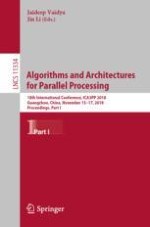2018 | Buch
Algorithms and Architectures for Parallel Processing
18th International Conference, ICA3PP 2018, Guangzhou, China, November 15-17, 2018, Proceedings, Part I
herausgegeben von: Jaideep Vaidya, Jin Li
Verlag: Springer International Publishing
Buchreihe : Lecture Notes in Computer Science
